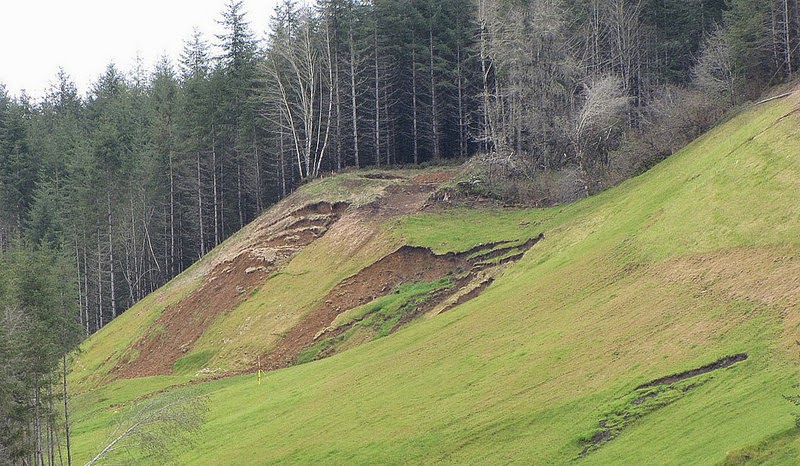New landslide maps have been developed that will help the Oregon Department of Transportation determine which coastal roads and bridges in Oregon are most likely to be usable following a major subduction zone earthquake that is expected in the future of the Pacific Northwest.
The maps were created by Oregon State University and the Oregon Department of Geology and Mineral Industries, or DOGAMI, as part of a research project for ODOT. They outline the landslide risks following a large earthquake on the Cascadia Subduction Zone.
The mapping is part of ongoing ODOT efforts to preserve the critical transportation routes that will facilitate response and recovery.
“Landslides are a natural part of both the Oregon Coast Range and Cascade Range, but it’s expected there will be a significant number of them that are seismically induced from a major earthquake,” said Michael Olsen, an assistant professor in the OSU School of Civil and Construction Engineering. “A massive earthquake can put extraordinary additional strain on unstable slopes that already are prone to landslides.”
Landslides are already a serious geologic hazard for western Oregon. But during an earthquake, lateral ground forces can be as high as half the force of gravity.
The Coast Range is of special concern, officials say, because it will be the closest part of the state to the actual subduction zone earthquake, and will experience the greatest shaking and ground movement. The research identified some of the most vulnerable landslide areas in Oregon as parts of the Coast Range between Tillamook and Astoria, and from Cape Blanco south to the California border – in each case, from the coast to about 30 miles inland.
“Major landslides have been identified by DOGAMI throughout western Oregon using high-resolution lidar mapping,” Olsen said. “Some experts believe that a number of these landslides date back to the last subduction zone earthquake in Oregon, in 1700. Coast Range slopes that are filled with weak layers of sedimentary rock are particularly vulnerable, and many areas are already on the verge of failure.”
According to the new map, the highway corridors to the coast that will face comparatively less risk from landslides will be Oregon Highway 36 from near Eugene to Florence; Oregon Highway 38 from near Cottage Grove to Reedsport; Oregon Highway 18 from Salem to Lincoln City; and large portions of U.S. Highway 30 from Portland to Astoria. However, landslides or other damages could occur on any road to the coast or in the Cascade Range due to the anticipated high levels of ground shaking.
The new research, along with other considerations, will help ODOT and other officials determine which areas merit the most investment in coming years as part of long-term planning for the expected earthquake. Given the high potential for damage and minimal resources available for mitigation, experts may choose to focus their efforts on highway corridors that are expected to receive less damage from the earthquake, Olsen said.
The research reflected in the new map considered such factors as slope, direction of ground movement, soil type, vegetation, distance to rivers, roads and fault locations, peak ground acceleration, peak ground velocity, annual precipitation averages, and other factors.
ODOT, Oregon State and DOGAMI have been state leaders in research on risks posed by the Cascadia Subduction Zone, earthquake and tsunami impacts, and initiatives to help the state prepare for a future disaster that scientists say is a certainty.
Officials said it’s important to consider not just the damage to structures that can occur as a result of an earthquake, but also landslide and transportation issues.
“ODOT recognizes the potential not only for casualties due to landslides during and after an earthquake, but also for the likelihood of isolating whole segments of the state’s population,” one ODOT official said. “Thousands of people in the coastal communities would be stranded and cut off from rescue, relief and recovery that would arrive by surface transport.”
ODOT recently completed a seismic vulnerability assessment and selected lifeline corridor routes to prioritize following an earthquake. ODOT also maintains an unstable slopes program, evaluating the frequency of rockfalls and landslides affecting highway corridors.
DOGAMI recently released another open file report as part of the Oregon Resilience Plan, which evaluated multiple potential hazards resulting from a Cascadia subduction zone earthquake, including landslides, liquefaction, and tsunamis.
Some recent efforts at OSU have also focused on understanding the different concerns raised by a subduction zone earthquake compared to the type of strike-slip faults more common in California, on which many seismic plans are based. Subduction earthquakes tend to be larger, affect a wider area and last longer.
Reference:
DOGAMI Open-File Report O-15-01, “Landslide Susceptibility Analysis of Lifeline Routes in the Oregon Coast Range,” by Rubini Mahalingam; Michael J. Olsen; Mahyar Sharifi-Mood; and Daniel T. Gillins, Oregon State University School of Civil and Construction Engineering.
ODOT Research Report SPR-740, “Impacts of Potential Seismic Landslides on Lifeline Corridors,” by Michael J. Olsen; Scott A. Ashford; Rubini Mahalingam; Mahyar Sharifi-Mood; Matt O’Banion and Daniel T. Gillins, Oregon State University School of Civil and Construction Engineering. Download the report: http://1.usa.gov/18352DF
Note : The above story is based on materials provided by Oregon State University.











